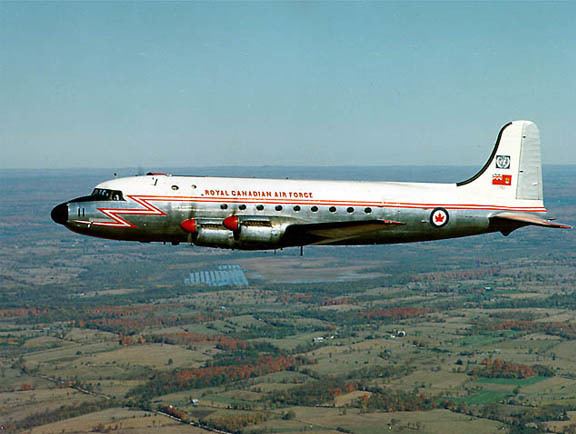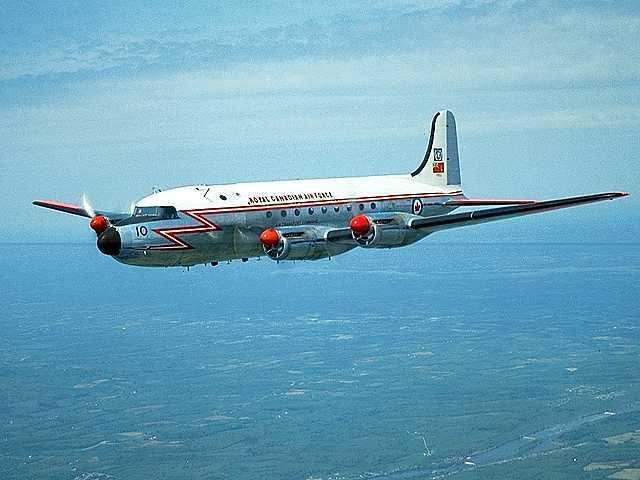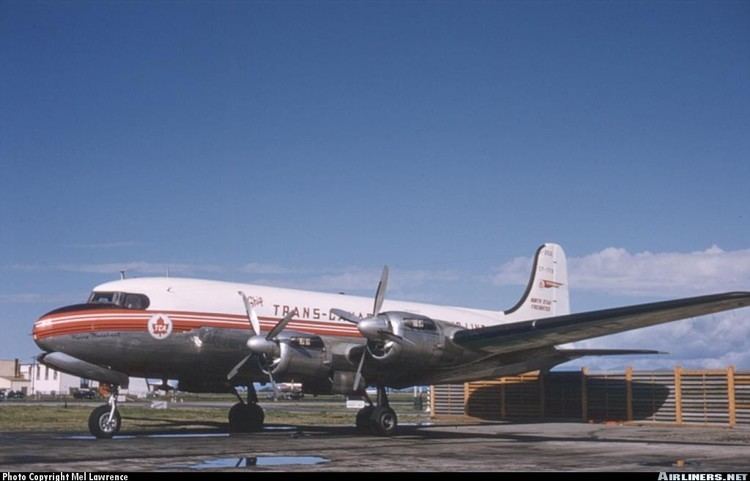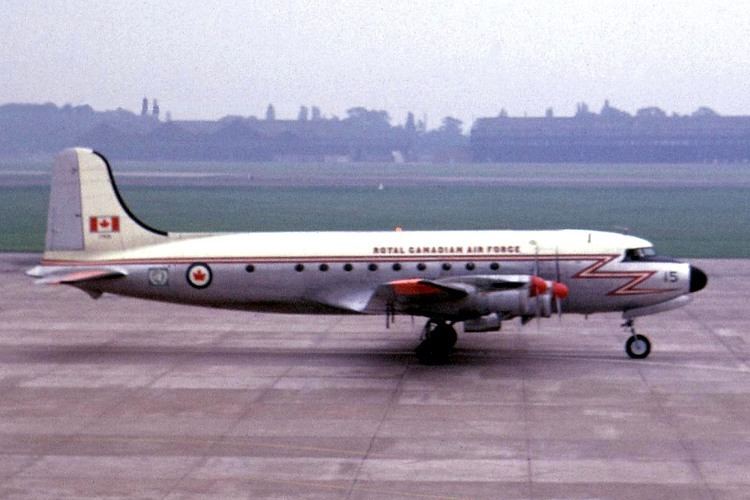Wingspan 36 m First flight July 15, 1946 | Length 29 m | |
 | ||
The Canadair North Star was a 1940s Canadian development of the Douglas C-54 / DC-4 aircraft designed for Trans-Canada Air Lines - TCA. Instead of radial piston engines found on the Douglas design, Canadair used Rolls-Royce Merlin engines to achieve a higher cruising speed of 325 mph compared with the 227 mph of the standard DC-4. Requested by TCA in 1944, the prototype flew on 15 July 1946 and the type was used by various airlines and by the RCAF. It proved to be reliable but noisy when in service through the 1950s and into the 1960s. Some examples continued to fly into the 1970s, converted to cargo aircraft.
Contents
- Flight replicas canadair north star model details fsx hd
- Design and development
- Operational history
- RCAF service
- TCA and BOAC operations
- Later service
- Accidents and incidents
- Surviving North Stars
- Specifications DC 4 M2 North Star
- References

Flight replicas canadair north star model details fsx hd
Design and development

Canadair Aircraft Ltd. took over the Canadian Vickers Ltd. operations on 11 November 1944. Besides the existing Consolidated PBY Canso flying patrol boats in production, a development contract to produce a new variant of the Douglas DC-4 transport was still in effect. The new Canadair DC-4M powered by Rolls-Royce Merlin engines mounted in Rolls-Royce Universal Power Plant (UPP) installations emerged in 1946 as the "North Star." More than just an engine swap, the North Star had the Douglas DC-6 nose, landing gear and fuselage shortened by 80 in (2 metres), DC-4 empennage, rear fuselage, flaps and wing tips, C-54 middle fuselage sections, wing centre- and outer-wing panels, cabin pressurisation, a standardised cockpit layout and a different electrical system.

Canadair built 71 examples under the designations: North Star, DC-4M, C-4 and C-5. With the exception of the single C-5 (which had Pratt & Whitney R-2800 engines, as fitted to the Douglas DC-6), these variants were all powered by Rolls-Royce Merlin engines and 51 of the production examples were pressurized.
Operational history

Trans-Canada Air Lines (TCA), the Royal Canadian Air Force (RCAF), Canadian Pacific Airlines (CPA) and British Overseas Airways Corporation (BOAC) were the principal operators of the "North Star", with the CPA examples known as the "Canadair Four" and BOAC examples known as the "Argonaut".
RCAF service

The RCAF North Stars were unpressurized and were used on a variety of transport duties. Like other North Stars, they were notorious for the high level of cabin noise caused by the Merlin engines, as unlike the radials of the DC-4, the exhaust from the individual cylinders is not collected and exhausted via a single outlet, but instead exits the separate individual ejector-exhaust stubs in high-pressure bursts.
In an effort to reduce cabin noise, the sole C-5 variant was powered by Pratt & Whitney R-2800 Double Wasp engines that were considerably quieter. The only C-5 was delivered to the RCAF in 1950, entering service with No. 412 Transport Squadron RCAF in Uplands, Ottawa, specially outfitted for the transportation of VIP passengers. It was used to transport the Canadian Prime Minister, the Queen, and numerous other dignitaries on various high-profile missions, serving faithfully for 17 years, later becoming a crew trainer before being retired and sold in the United States.
North Stars were also employed by 412 Squadron RCAF on various VIP transport duties and, overall, the aircraft provided valuable and reliable long range transport services for the RCAF. From 1950 to 1952, during the Korean War, RCAF North Star aircraft were employed ferrying supplies to Korea across the Pacific Ocean. They flew 599 round trips over the Pacific and delivered seven million pounds of cargo and 13,000 personnel on return trips. They flew 1.9 million miles without a fatal crash and outhauled the United States Air Force C-54s on the Korean run. After 1967, the remaining North Stars were assigned to No. 426 Transport Squadron RCAF initially deployed to Dorval, Quebec and then to Trenton, Ontario. Gradually, their service life diminished in the 1970s and most were declared surplus.
TCA and BOAC operations
TCA received its fleet of twenty DC-4M-2 North Stars during 1947 and 1948 and operated them on routes within Canada and to the USA until 1961. Starting in 1954 the North Stars were replaced on TCA's routes to Europe by Lockheed Super Constellations. To deal with passenger complaints about noise, TCA engineers developed a cross-over for the fuselage-side exhausts that reduced cabin noise by 6-8 decibels. "In the cabin, noise is reduced to 102 decibels near the windows and 93 at the aisle."
BOAC ordered 22 DC-4M-4s and named them the "Argonaut class", each aircraft having a classical name beginning with "A". The Argonauts were delivered between March and November 1949; they flew to South America, Africa, the Middle East and the Far East from London Heathrow Airport until 1960.
On 1 February 1952 the BOAC Argonaut Atalanta G-ALHK transported Princess Elizabeth and the Duke of Edinburgh to Kenya to begin a Commonwealth tour. Some days later, 6 February, it was again Atalanta G-ALHK which returned the newly acceded Queen Elizabeth II to England upon the death of her father, King George VI.
Rolls-Royce also developed a quieter 'cross-over' exhaust system for the DC-4M, the modifications being supplied in a kit allowing installation on the aircraft by the operator. The engine thus modified became the 'Merlin TMO' in contrast to the unmodified engine, the Merlin TML - Transport Merlin L. The modified exhaust conferred an increase in horsepower over the unmodified system of 38 hp, resulting in a 5 knot improvement in true air speed. Sound levels were reduced by between 5 and 8 decibels. Still air range of the aircraft was also improved by around 4 per cent. BOAC Argonauts initially, due to schedules being unable to be changed, had only the inner engines so-modified, the remaining outer engines being changed to the new exhaust system when time was available.
Later service
After service with TCA and BOAC, the surplused North Stars and Argonauts had long careers with secondary operators such as British Midland Airways, Overseas Aviation and other charter companies. Cargo conversions of available airframes also lengthened the service life of Argonauts and North Stars.CF-UXA,ex-RCAF 17510 was the last DC-4M in airline service, completing its final flight on 19 June 1975 at Miami, Florida. Despite the onset of jet airliners in the 1950s, the rugged Canadair North Star found a niche in both military and civil use.
Accidents and incidents
Surviving North Stars
The sole surviving airframe in existence is an RCAF C-54GM example (17515 ), which is currently undergoing restoration at the Canada Aviation and Space Museum, Ottawa, Ontario.
Specifications (DC-4-M2 North Star)
Data from
General characteristics
Performance
